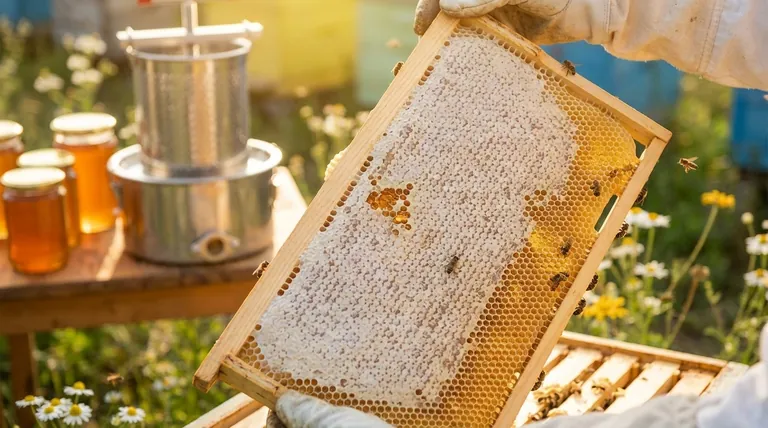For a successful honey harvest, the visual state of your frames is the most reliable indicator of readiness. Your frames should be at least 80% capped with a beeswax seal before you consider harvesting them. This capping is the bees' signal that they have finished the dehydration process, reducing the nectar's water content to below 18% to create stable, long-lasting honey.
The "80% capped" rule is not arbitrary; it's a visual confirmation that the bees have fully cured the nectar into honey. Harvesting frames with a lower percentage of capped cells risks introducing honey with high water content, which can lead to fermentation and spoil your entire batch.

Why Capping is the Critical Signal
To harvest high-quality honey, you must understand what the bees are communicating through their work. The wax cap on a cell of honey is the final step in a meticulous process.
From Watery Nectar to Stable Honey
Bees collect nectar from flowers, which is a sugary liquid but has a very high water content, often over 60%. Back in the hive, the bees work to actively dehydrate this nectar by passing it among themselves and fanning it with their wings.
This process reduces the water content to below 18%, a critical threshold that prevents yeast and other microbes from growing.
The Purpose of the Wax Cap
Once the bees are satisfied that the honey has reached the correct, stable moisture level, they seal the cell with a fresh, white or yellow-white wax coating. This cap protects the finished honey from absorbing ambient moisture and preserves it indefinitely.
The cap is your guarantee that the product inside the cell is finished and ready.
The "80% Capped" Rule Explained
The 80% guideline is a practical balance between ensuring honey quality and achieving a timely harvest.
Why Not 100%?
Waiting for every single cell on every frame to be 100% capped is the absolute ideal, but it's not always practical. Bees may not cap the cells at the very edges of the frame, or a strong nectar flow may mean you need to make space for them to continue working.
The 80% rule ensures the vast majority of the honey in the frame is fully cured and stable, providing a safe margin for the small amount that may not be.
Verifying Uncapped Cells
If you have a frame that is mostly capped but has some open cells, you can perform a quick "shake test." Hold the frame horizontally over the open hive and give it a firm, downward shake.
If watery nectar flies out, it is not ready. If the liquid stays in the cells, its viscosity is high enough (meaning low water content) to be safely harvested along with the capped portions.
The Consequences of Harvesting Too Early
Patience is essential in beekeeping, and this is especially true for harvesting. Removing frames before they are sufficiently capped can ruin your efforts.
The Risk of Fermentation
Honey with a water content above 18-20% is unstable. Naturally occurring wild yeasts in the honey can begin to multiply, feeding on the sugars and starting a fermentation process.
This will give your honey a sour, "off" taste and a bubbly appearance, rendering it spoiled.
Contaminating Your Entire Batch
The danger is not limited to a single "wet" frame. If you extract honey from an uncured frame and mix it with gallons of perfectly cured honey, the high moisture content of the uncured batch can raise the overall water level of the entire container.
This can cause your whole harvest to begin fermenting days or weeks after you've bottled it.
Making the Right Choice for Your Hive
Use the condition of the frames to guide your harvesting decision based on your specific goals.
- If your primary focus is maximum quality and long-term storage: Aim for 90-100% capped frames to guarantee the lowest possible moisture content and greatest stability.
- If your primary focus is a timely harvest during a strong nectar flow: Use the 80% rule as your reliable trigger, and verify any significant uncapped areas with the shake test.
Trust the bees' signal; the wax cap is your guarantee of a perfect harvest.
Summary Table:
| Frame Condition | Key Indicator | Implication for Harvest |
|---|---|---|
| Ready to Harvest | At least 80% of cells capped with beeswax | Honey is stable (water content <18%), safe for extraction and storage. |
| Not Ready / Risky | Less than 80% capped, fails the shake test | High risk of fermentation; can spoil the entire batch if harvested. |
| Ideal for Storage | 90-100% capped | Guarantees maximum quality and long-term stability. |
Ensure every harvest is a success with the right equipment from HONESTBEE.
Harvesting high-quality honey requires precision and reliable tools. At HONESTBEE, we supply commercial apiaries and beekeeping equipment distributors with the durable, wholesale-focused supplies needed for efficient and successful operations—from uncapping knives to extractors.
Contact our expert team today to discuss your wholesale needs and how our equipment can support your beekeeping success.
Visual Guide

Related Products
- Stainless Steel Honey Press Wax Press with Tank
- Stainless Steel Manual Honey Press with Guard for Pressing Honey and Wax
- Electric Flatting and Embossing Machine with Tray for Beekeeping
- Professional Galvanized Hive Strap with Secure Locking Buckle for Beekeeping
- Honey Wax Separating Wax Press with Metal Screw Wax Separator Machine
People Also Ask
- What are the main differences between centrifugal extractors and honey presses? A Guide for Commercial Apiaries
- How does the press method for extracting honey work? A Simple, Low-Cost Guide for Beekeepers
- What are the key features of a honey press? Maximize Yield with Durable, Efficient Extraction
- What are the multipurpose functionalities of a honey press? Versatile Harvesting for Beekeepers & Homesteaders
- How was the honey press cleaned after use? Quick vs. Deep Cleaning Methods Explained



















